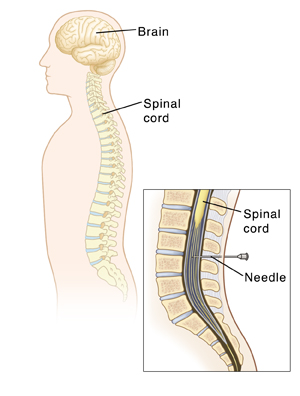Spinal fluid fills the space around the brain and spinal cord. This fluid acts as a cushion. During a spinal tap (lumbar puncture) procedure, a needle is passed through the skin and the membrane around the spinal cord in the lower back. This allows the doctor to remove a small sample of spinal fluid. This fluid provides important information about the health of your brain and spinal cord. Normally, as the needle is removed, the puncture hole seals off and no more fluid comes out. But sometimes the hole does not seal correctly and spinal fluid leaks into the nearby tissues.
If you lose too much spinal fluid from a leak at the puncture site, the spinal fluid pressure goes down and a headache occurs. This headache may be mild or severe. The pain is often worse when you sit or stand and gets better or goes away when you lie down. There may also be dizziness, nausea, and blurred vision. The headache often goes away in 24 hours. No treatment is needed unless the headache is very severe or lasts longer than 24 hours.
Home care
-
Once you get home, rest lying down for 12 hours.
-
Try not to sit or stand for the first 12 hours. It's OK to get up to eat and go to the bathroom for short amounts of time.
-
Drink extra fluids for the next 24 hours. On a normal day, healthy men should have about 125 ounces (3.7 liters) of total water, from all drinks and food per day. Healthy women should take in about 91 ounces (2.7 liters) of total water, from all drinks and food per day.
-
Caffeinated drinks can help this type of headache. Unless told otherwise, you may have coffee or another caffeinated drink.
-
If you were given medicine for nausea, take it as directed.
Follow-up care
Follow up with your healthcare provider, or as advised.
When to get medical advice
Call your healthcare provider right away if any of these occur:
-
Headache remains severe for more than a few hours after the procedure
-
Headache gets worse with sitting or standing
-
Vomiting repeatedly (unable to keep liquids down)
-
Numbness or tingling of the legs
-
Unable to pass urine
-
Bleeding or pain at the injection site
-
Confusion or trouble thinking
-
Fever of 100.4°F (38°C) or above, or as directed by your provider


